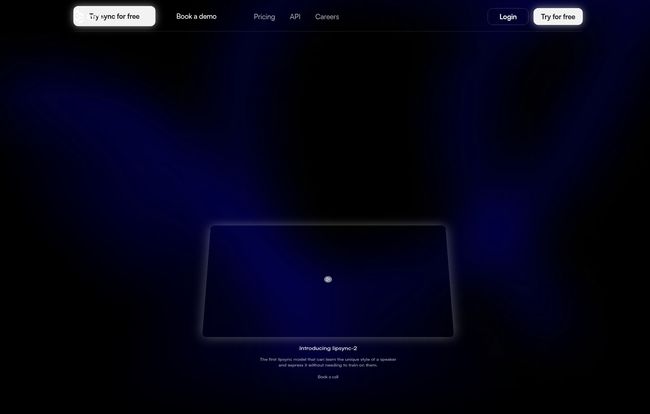We’ve all seen it. That foreign film on Netflix or a YouTube video from an international creator where the dubbing is just… off. The words are saying one thing, but the actor’s mouth is doing a completely different dance. It’s distracting, it’s cringey, and it yanks you right out of the experience. For years, as a content creator trying to reach a wider audience, this has been my personal uncanny valley. You either spend a fortune on a professional dubbing studio or settle for something that looks a bit like a poorly-synced kung fu movie.
It’s been a constant headache. But every so often, a tool comes along that makes me sit up and pay attention. A tool that feels less like an incremental update and more like a genuine leap forward. Today, I want to talk about one of those tools: Sync.so.
So, What Exactly is Sync.so?
On the surface, Sync.so (from Sync Labs) is an AI video tool that makes a person’s lips in a video perfectly match any audio track you give it. Simple, right? But that’s like saying a Ferrari is just a way to get from A to B. The magic is in the execution.
What really gives this platform credibility, for me, is the team behind it. These are the same folks who created Wav2Lip. If you’ve been in the AI video space for a while, that name should ring a bell. Wav2Lip was one of the foundational open-source models that showed the world what was possible with AI lipsyncing. Sync.so feels like the polished, powerful, and commercially-ready evolution of that legacy. It's built for creators, marketers, and even big-time developers who need to do this stuff at scale.

Visit sync.so
The Features That Actually Matter
I’ve seen a million feature lists designed to sound impressive but feel hollow. Here, the features feel practical and aimed at solving real-world problems for people who make video content.
Uncannily Good AI Lipsyncing
This is the main event. You upload a video, you upload an audio file (or even just text), and Sync.so gets to work. It reanimates the speaker’s mouth to match the new audio with frightening accuracy. It works on live-action footage, animated characters, and even other AI-generated talking heads. I’ve thrown a few test clips at it, and the results are smooth. It's not just flapping the lips open and shut; there's a nuance to the mouth shapes that just looks right. This is the core technology, and it’s solid as a rock.
Go Global with Voice Cloning and Video Translation
Okay, this is where my SEO-brain and content-strategy-brain start firing on all cylinders. Sync.so isn’t just a lipsync tool; it’s a full-blown video translation platform. Imagine taking your latest marketing video, originally in English, and creating perfectly dubbed and synced versions in Spanish, German, and Japanese. All using the same speaker's voice profile.
The voice cloning feature is the secret sauce here. It can analyze the original speaker's voice and then generate the translated audio in a voice that sounds just like them, but speaking a different language. The potential for global brand consistency and audience connection here is massive. No more hiring a different voice actor for every single region. This is how you truly scale content internationally.
More Than Just a One-Trick Pony
While translation is a huge use case, the tool is flexible. You can use it for:
- Creative Ads: Need to A/B test a different call to action without reshooting the whole ad? Just record the new line of audio and sync it.
- Dialogue Replacement: Did an actor flub a line on set? Was there a noise interruption during a take? Instead of expensive ADR (Automated Dialogue Replacement) sessions, you could potentially fix it right here.
- Animation: For animators, this could be a huge timesaver. Animate your character once and then generate different language versions or dialogue variations without having to re-render complex facial movements.
The Big Question: What Does Sync.so Cost?
Alright, let’s talk money. This is often where great tech falls down for smaller creators. Sync.so uses a hybrid pricing model, which might be a little confusing at first glance but actually makes a lot of sense once you break it down. You pay a monthly subscription fee which gives you access to the platform and a certain number of credits, and then you pay for usage based on the minutes of video you process.
Think of it like an arcade. You pay to get in, and then you pay for the games you want to play. Here's a simplified look at their tiers, but you should check their official pricing page for the latest details.
| Plan | Monthly Cost | Best For | Key Limits |
|---|---|---|---|
| Hobbyist | $5 | Individuals just starting out | 1 min max video length, 1 voice clone |
| Creator | $19 | Content creators, freelancers | 5 min max video length, 5 voice clones |
| Growth | $49 | Small agencies, businesses | 10 min max video length, 15 voice clones |
| Scale | $249 | Larger teams, high volume | 30 min max video length, 10 team seats |
Note: On top of the monthly fee, there are per-minute or per-frame costs that vary depending on the AI model you use. The newer, higher-quality models cost a bit more.
In my opinion, this structure is fair. It allows a hobbyist to get their feet wet for the price of a coffee, while letting a power user scale up without hitting a hard ceiling. You just have to be mindful of your usage.
My Honest Take: The Good and The Could-Be-Better
What I Love
The quality of the lipsync is, without a doubt, the star of the show. It’s incredibly natural and avoids that robotic puppet look that plagues other tools. The versatility is another huge plus. This isn't just for film dubbing; it's for marketers, animators, and social media creators. The voice cloning tech combined with multilingual support is a genuine game-changer for anyone with a global ambition.
What Gives Me Pause
The variable pricing, while fair, does require you to do a little math. You can't just set it and forget it if you're on a tight budget; you have to monitor your usage. It's not a con, exactly, but its something to be aware of. Also, like any platform of this type, it requires you to upload your source video and audio. That’s just the nature of the beast, but for those working with highly sensitive or proprietary footage, it’s a consideration for their security protocols.
Frequently Asked Questions About Sync.so
Is the payment a recurring subscription?
Yes, the plans are based on a recurring monthly subscription, plus the usage-based costs for the video processing you do.
What's the highest video resolution Sync.so can handle?
The platform supports up to 4K resolution, which is fantastic for professional workflows. Obviously, processing higher-res video will take more time and likely cost more in usage credits.
Can I use my own Text-to-Speech (TTS) key?
Yes, on the higher-tier plans (Creator and up), you can integrate your own TTS API key, giving you more control over the voices you use.
Can I get rid of the watermark?
Whitelabeling, or removing the Sync Labs watermark from generated videos, is available on the Growth and Scale plans. The Hobbyist and Creator plans will include a watermark.
What kind of video formats does it support?
It supports all the common formats you'd expect, like MP4 and MOV. The workflow is pretty straightforward for any standard video file.
Is Sync.so Worth Your Time and Money?
So, we circle back to the original problem: the curse of bad dubbing. Does Sync.so solve it? I’d say it gets us about 95% of the way there, which is a massive leap from where we were just a couple of years ago. It democratizes technology that used to be exclusively in the hands of high-end post-production houses.
For content creators, marketers, or small businesses looking to expand their reach without breaking the bank, this tool is more than just compelling; it feels almost necessary. It’s an investment, for sure, especially if you’re producing a lot of content. But it’s an investment in a global audience, in better storytelling, and in staying ahead of the curve.
If you've ever looked at your analytics and wished you could connect with that audience in another country, you should seriously give Sync.so a look. It might just be the bridge you need to cross your own uncanny valley.



